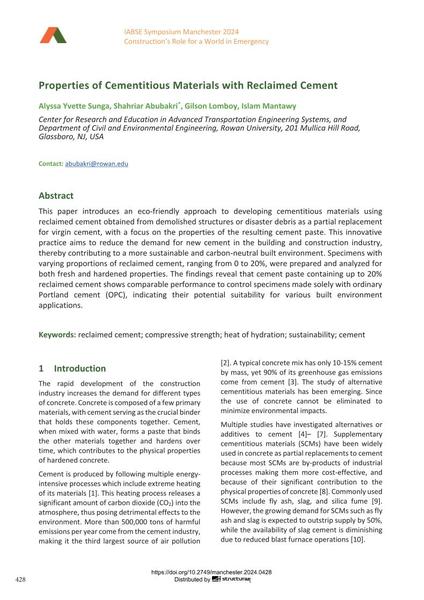Properties of Cementitious Materials with Reclaimed Cement

|
|
|||||||||||
Bibliographic Details
| Author(s): |
Alyssa Yvette Sunga
(Center for Research and Education in Advanced Transportation Engineering Systems, and Department of Civil and Environmental Engineering, Rowan University, 201 Mullica Hill Road, Glassboro, NJ, USA)
Shahriar Abubakri (Center for Research and Education in Advanced Transportation Engineering Systems, and Department of Civil and Environmental Engineering, Rowan University, 201 Mullica Hill Road, Glassboro, NJ, USA) Gilson Lomboy (Center for Research and Education in Advanced Transportation Engineering Systems, and Department of Civil and Environmental Engineering, Rowan University, 201 Mullica Hill Road, Glassboro, NJ, USA) Islam Mantawy (Center for Research and Education in Advanced Transportation Engineering Systems, and Department of Civil and Environmental Engineering, Rowan University, 201 Mullica Hill Road, Glassboro, NJ, USA) |
||||
|---|---|---|---|---|---|
| Medium: | conference paper | ||||
| Language(s): | English | ||||
| Conference: | IABSE Symposium: Construction’s Role for a World in Emergency, Manchester, United Kingdom, 10-14 April 2024 | ||||
| Published in: | IABSE Symposium Manchester 2024 | ||||
|
|||||
| Page(s): | 428-434 | ||||
| Total no. of pages: | 7 | ||||
| DOI: | 10.2749/manchester.2024.0428 | ||||
| Abstract: |
This paper introduces an eco-friendly approach to developing cementitious materials using reclaimed cement obtained from demolished structures or disaster debris as a partial replacement for virgin cement, with a focus on the properties of the resulting cement paste. This innovative practice aims to reduce the demand for new cement in the building and construction industry, thereby contributing to a more sustainable and carbon-neutral built environment. Specimens with varying proportions of reclaimed cement, ranging from 0 to 20%, were prepared and analyzed for both fresh and hardened properties. The findings reveal that cement paste containing up to 20% reclaimed cement shows comparable performance to control specimens made solely with ordinary Portland cement {OPC), indicating their potential suitability for various built environment applications. |
||||
| Keywords: |
sustainability compressive strength cement heat of hydration reclaimed cement
|
||||
